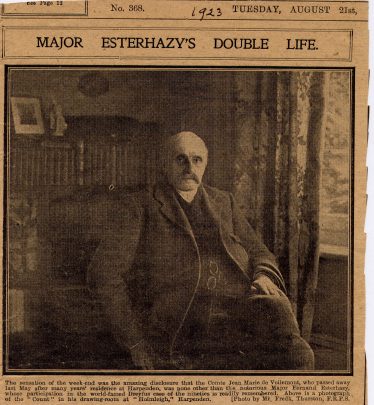
Portrait of Count de Voilemont by Frederick Thurston FRPS, c. 1912, in the library at The Elms.
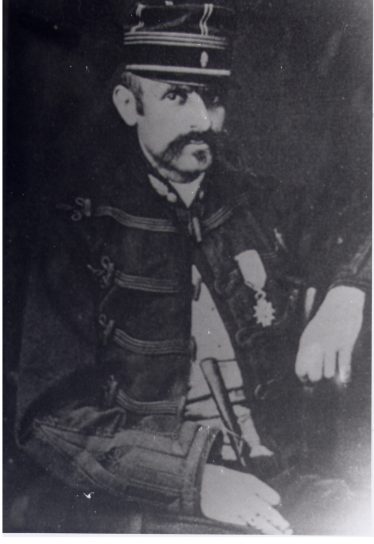
Major Esterhazy, c 1890
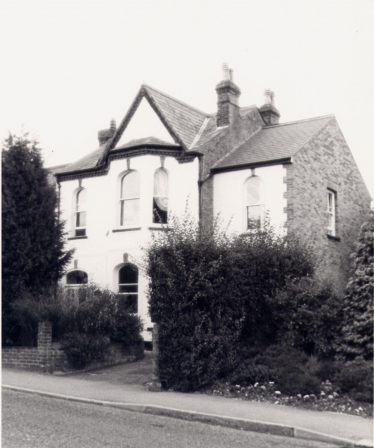
The Elms, 140 Station Road, Harpenden, home to Mr and Mrs Fitzgerald, 1910-13 – Les Casey, Sept 1990
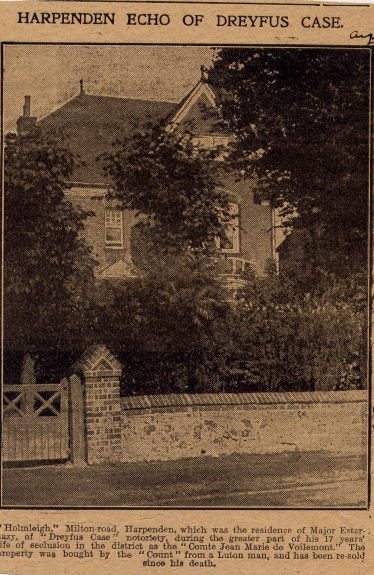
Holmleigh (21) Milton Road, Harpenden, home to the Count & Countess de Voilemont, 1913-1923
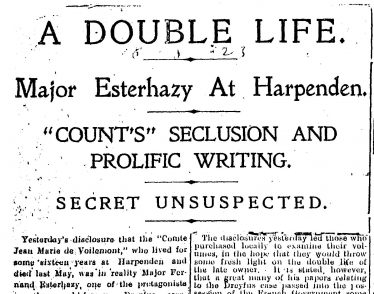
Headline in Herts Advertiser, 18 August 1923
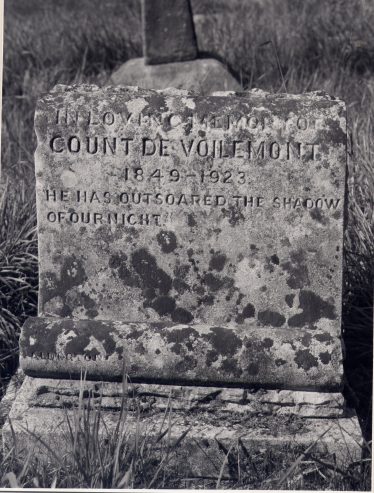
Gravestone in St Nicholas Parish churchyard, c.1983 – E Meadows LHS 959.

Esterhazy’s gravestone, February 2011
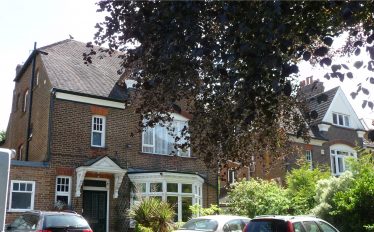
21 Milton Road, 2011
* A compilation from notes of a talk by Gwen Hollington to the Local History Society in 2000 (from Newsletter 82, May 2000) and extracts from local press cuttings at the time of the disclosure of Count de Voilemont’s identity in August 1923, held in the Local History archives (RB32) A longer account by Professor Eric Cahm, from Newsletter 86, May 2001, is appended as a document that can be downloaded.
The Dreyfus Affair
Charles-Marie-Ferdinand Walsin- Esterhazy, the guilty party in the Dreyfus Affair, was a descendant of the noble Hungarian family and a soldier in the French Army. He was a spoilt only child and his extravagant lifestyle and weakness for gambling soon dissipated the considerable sum of money left him at the age of 22 when his mother died. A marriage for money ended in divorce so, desperate for money to fund his lifestyle, he sold military information to the German Embassy in Paris. For his first bordereau he was paid 400 Fr. but the Germans lost interest in the material he was providing.
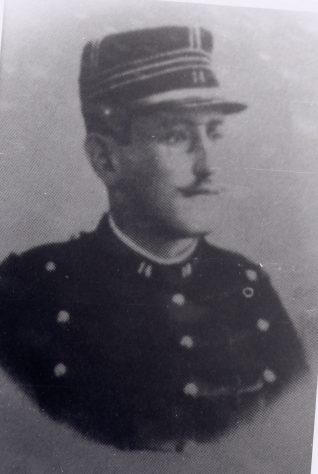
Captain Dreyfus
Suspicion of a leak fell on Captain Alfred Dreyfus who, like Esterhazy, worked at the Bureau de Statistique, the Secret Service. In 1894 Dreyfus was court-martialled, found guilty, condemned to degradation and deportation for life and sent to Devil’s Island, Guiana where he was deprived of literature and letters, not allowed to have a drinking cup, to speak or to see the view. The unremitting agitation of family and friends, especially his brother Mathieu, secured a retrial. He was again found guilty but shortly pardoned as a result of public outcry.
Refuge in Harpenden
Esterhazy was allowed, by an embarrassed French government, to slip out of France after the retrial. He came first to London then, with his lady companion (Alsace Louise Mathey), to Harpenden in 1909, under aliases – first as Mr and Mrs Fitzgerald. At first they lodged with Mr and Mrs Humphrey, at Maisonette, (46) Tennyson Road, and then at The Elms, 140 Station Road from the end of 1910 to 1913, where their adjoining neighbours in Oak Cottage, Mr & Mrs Jesse Hall, heard ‘a lot of typing’ at all times of night. Their son Ronald Hall, who began working at the Post Office as a telegraph boy, remembered when they changed their name to de Voilemont on moving to Holmleigh (21) Milton Road, which they bought at the end of 1913. Here they stayed under the alias of Count and Countess de Voilemont until his death in 1923 aged 74. Father Longstaff conducted the funeral service at Our Lady of Lourdes and then the small cortege processed to St Nicholas churchyard for the burial. The epitaph on his tombstone in St Nicholas’ churchyard was a fashionable quotation from Shelley’s ‘Adonais’ v.40 – “He has outsoared the shadow of our night” – words that few would have sympathy with. The ‘Countess’ moved away soon afterwards, and little is known of her after that.
Surprise at the disclosure
It was not until three months after his death that news broke that newly buried Count de Voilemont was the notorious Esterhazy. The Herts Advertiser reported on “A Double Life” on 18 August 1923, and the ‘intense surprise’ of Harpenden residents at the disclosure. According to the news-cutting, the Count’s closest local friend appears to have been the auctioneer, Mr R G Harding, who was ‘from time to time invited to dinner at Holmleigh when the Count had a few friends down from London for a weekend party. “He was a very nice man and I had a great opinion of him. He was excellent to do business with and a very interesting man to talk to. He was of very aristocratic appearance.” The report continues: ‘It will be recalled that [Mr Harding] recently disposed of the furniture and library belong to the late “Count”’ – with the house and orchard being sold in separate lots. ‘A large number of people, both local and Londoners, assembled at the auction room whether to admire or to buy something belonging to the “titled” resident. … The disclosures yesterday led those who purchased locally to examine their volumes, in the hope that they would throw some fresh light on the double life of the late owner. It is stated, however, that a great many of his papers relating to the Dreyfus case passed into the possession of the French Government some time ago.’ The library consisted of works on military subjects and international problems, and included volumes on every country in Europe and volumes of a literary character in French, English Spanish and German. ‘Most of them went to big dealers from Charing Cross Road. A few remained in Harpenden and some reached Luton.’
Residents reminiscences
The following week a Herts Advertiser representative had made more enquiries among Harpenden residents (25 August 1923). ‘Many local residents have seen Esterhazy about the village, usually on horseback, or walking down Station Road to the post office, but few know much about him. … The Countess de Voilemont … was often seen of an afternoon, shopping’ including at Mr E R Billingham’s music shop in Station Road. One informant described how “when he went out, and latterly he never went beyond his garden and orchard, he usually wore a large black cloak. … Throughout his illness [pneumonia] he refused to have a nurse. … He lived in his bedroom practically all the time, with the windows tightly shut.” Others described how the doors and windows of the house were always kept barred, bolted and chained. Shrubs and trees had been so planted that it was impossible to see the house from a big part of the garden and from the road, according the Bevins family who bought the house very soon after the ‘Count’s’ death.
The Count’s literary work was carried out in the library overlooking the garden. He worked late into the night, writing on international politics for the Continental press – dispatched to foreign reviews and journals. During the war his all-night writing habits brought him to attention ‘on account of the lights showing from the windows of Holmleigh, especially when air raids took place’.
Who was ‘in’ on the secret?
It is probable that his identity was known to a few, such as the police sergeant in Harpenden to whom he had to report as an alien. The Countess, when interviewed by the Herts Advertiser (18 August 1923) said: “Really, I know nothing about the Dreyfus affair. My husband never discussed it with me, as it was a painful subject for him” and that he told her that he was not a spy for the Germans. The Herts Advertiser report of 25 August 1923 refers to comments by the London correspondent of Le Petit Parisien as saying that ‘in years gone by Esterhazy had presented himself on several occasions at the French Consulate in London without concealing his real identity. … It is understood that Esterhazy’s identity and place of residence was known to the British authorities, and a statement has been made that during the war he volunteered to visit Germany as an agent of the Allies.’

Comments about this page
I mentioned this chap to my father. Despite growing up in Harpenden I was not aware that Esterhazy lived here. The first story was told to him by a lady now long dead who had worked in Anscombes the well known department store that used to stand on the site of Waitrose. As a young women, she had worked in the lingerie department – and she recalls how Esterhazy, who had ‘many mistresses’, would bring young women into the store and buy lacy underwear for them.
And then secondly, a former rector of St Nicholas Church said that he had answered the door to the Rectory to a French woman swathed in black, she has asked to see Esterhazy’s grave. It is said that on seeing the grave she pulled back her hood and spat ferociously on it – so almost certainly a relative of the wrongly accused Dreyfus.
In October 2014, Madame Françoise Pinteaux-Jones visited Harpenden to meet the Mayor, Mary Maynard, and members of the Society, including John Versey, to see where Count de Voilement was buried and the houses where he had lived incognito from about 1909 until his death in 1923. She was preparing an article for a French language website devoted to events in the English-speaking world, and her ‘blog’ on Esterhazy was published in March 2015 – it can be accessed at: http://le-mot-juste-en-anglais.typepad.com/le_mot_juste_en_anglais/2015/03/harpenden-une-ville-anglaise-liée-a-laffiare-dreyfus.html
Add a comment about this page